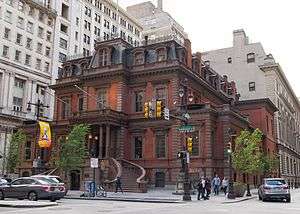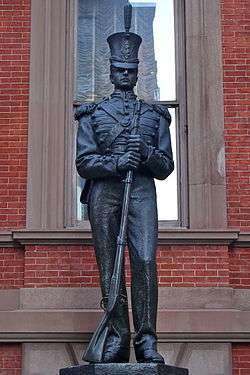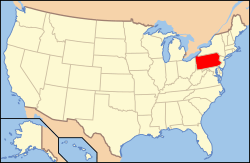Union League of Philadelphia
The Union League of Philadelphia, founded in 1862 as a patriotic society to support the Union and policies of Abraham Lincoln, laid the philosophical foundation of other Union Leagues (such as Union League Club of New York City and Union League Club of Chicago) across a nation torn by civil war. Today as a private members-only club, The League continues to be driven by its founding motto, Amor Patriae Ducit or Love of Country Leads and, consequently, has proudly supported the American military in each conflict since and including the Civil War.
Union League of Philadelphia | |
 The Union League Logo | |
   | |
| Location | 140 South Broad Street Philadelphia, Pennsylvania |
|---|---|
| Coordinates | 39°56′59″N 75°9′53.37″W |
| Built | 1864–65 |
| Architect | John Fraser Horace Trumbauer |
| Architectural style | Second Empire, Beaux Arts |
| NRHP reference No. | 79002331[1] |
| Added to NRHP | June 22, 1979 |
Though its early membership included many members of Philadelphia society, it was NOT an exclusive bastion of the elite and had Jewish and Catholic members when almost all other clubs in Philadelphia did not as League's purpose was patriotic not social. The membership remained committed to patriotism (and diversity was a byproduct of such) until the last decade of the 19th century.
Its present 4,000 male and female members continue to include leaders in academia, art, business, culture education, government, healthcare, law, medicine, politics, religion, and technology. Starting in the 1980s the League began to accept females, and once again after a lapse of roughly one hundred years, Catholic and Jewish members.
The League House headquarters occupies an entire city block in Center City Philadelphia. Built in 1865 in Second Empire-style, the building was added to the National Historic Register in 1979.
The League has hosted numerous U.S. presidents (and almost every Republican President since Abraham Lincoln), other heads of state, industrialists, entertainers and dignitaries from around the world.
The League has expanded to include five satellite facilities: (1) The Bungalow in Stone Harbor, New Jersey, (2) The Union League Golf Club at Torresdale (18-hole Donald Ross designed course and clubhouse), (3) Union League Guard House (1790 era dining facility in Gladwyne, Pennsylvania), (4) Union League National Golf Club (located in Swainton, New Jersey featuring a 27-hole course), and (5) Midtown Parking Garage (across Sansom Street from League headquarters).
The club is ranked first on the Five Star Platinum Club list and from 2016 through 2020 was the number 1 ranked City Club in the Country.[2]
History

The Union League of Philadelphia is the oldest and most prominent of the remaining loyalty leagues. Founded in 1862 as a patriotic society to support the Union and the policies of President Abraham Lincoln, it laid the philosophical foundation of other Union Leagues across a nation torn by Civil War. It has given loyal support to the American military in all conflicts since. Its motto is "Love of Country Leads." The only condition of membership at its founding was “unqualified loyalty to the government of the United States, and unwavering support of its efforts for the suppression of the Rebellion,” but its primary task was activist: “to discountenance and rebuke by moral and social influences all disloyalty to the Federal government . . .” see philadelphiaencyclopedia.org/archive/union-league-of-philadelphia/
As in 1862, its members prize tradition and represent the Philadelphia region's elite in business, education, religion as well as the arts and culture. Although no longer exclusively Republican or male in membership, The Union League of Philadelphia has maintained its identity as distinctly traditional and politically conservative. The club has hosted U.S. presidents, heads of state, industrialists, entertainers and visiting dignitaries from around the world.
 | |
The club's building, a classic Second Empire-style structure with a brick and brownstone façade and dramatic twin circular staircases leading to the main entrance on Broad Street, was designed by John Fraser and completed in May 1865 [the opening was originally scheduled for March 1865, with President Lincoln in attendance, but was delayed due to wartime construction supply shortages].
Two of the more prominent Presidents of Union League who served it and society as a whole with much success are identified below.Christopher Stuart Patterson, the Dean of the University of Pennsylvania Law School from 1890 through 1896, was the 13th President of the Union League in 1897 and 1898 and is known for volunteering to be a sergeant in Landis' First Battery of Philadelphia Light Artillery, and being wounded at the Battle of Gettysburg. David Charles Auten (1938 to 2020) used his expertise as a real estate and banking lawyer to help guide the Union League (as President and/or Board Member) when it made the important decision to acquire the large parking facility across Sansom Street. In addition to serving Union League, Auten also counseled the region's leading business and charitable organization in his role as (1) managing partner of the Philadelphia office of Reed Smith LLP for 16 years, (2) one of the foremost experts in laws of banking and laws of Usury in United States in the last quarter of 20th century; (3) serving a variety of institutions related to his college and law school alma mater in roles as (a) University of Pennsylvania Trustee from 1977 to 1988, (b) Penn Medicine Trustee, (c) University of Pennsylvania School of Arts and Sciences Overseer, (d) Penn General Alumni Society President, (e) Penn Annual Giving Chair, (f) Penn Interfraternity Alumni Council President, and (g) Penn Presbyterian Medical Center Trustee and Chair of the Board of Trustees (where he was instrumental in the 1995 acquisition of Penn Presbyterian by Penn Medicine); and (4) serving Committee of Seventy as Board Member https://almanac.upenn.edu/volume-66-number-36
In 1905, Philadelphia architect (and Union League member) Horace Trumbauer won a design competition to build major additions to the building. The Beaux Arts-style additions, completed in 1910 and 1911, expanded the length of the building to a city block. The building was listed on the National Register of Historic Places in 1979.
Adorning the walls and hallways is the club's collection of art and artifacts, a chronicle of Philadelphia's imprint upon the American landscape. A Heritage Center was added to provide a permanent place to store and display the extensive collection of Civil War-related documents and objects. While much of the historical content is located at the Heritage Center, the club does maintain a large library for members with more than 26,000 volumes. Members can check out books or read them in the library at their leisure.[3]
Also inside the club are three restaurants for members to enjoy; Café Meredith, Founders and 1862 by Martin Hamann, each with a distinct cuisine.[4]
The club has three charitable foundations: the Abraham Lincoln Foundation, the Youth Work Foundation and the Scholarship Foundation which educate the public about U.S. history, recognize student role models in schools and provide awards and scholarships to deserving students.
Heritage Center
In 2011, the Foundations of the Union League—three non-profit charitable organizations founded by the membership of the Union League—completed construction on The Heritage Center, which includes a multi-purpose space for events, a museum space for exhibitions and a research center. The Center houses the historic collections of the Union League of Philadelphia, the Abraham Lincoln Foundation of Philadelphia, the two-dimensional collections of the Civil War Museum of Philadelphia, and the collections of both the Military Order of the Loyal Legion of the United States (MOLLUS) and the Dames of the Loyal Legion (DOLLUS). The collections are all available for research.
The Heritage Center has regular public open hours, and every February, weather permitting, there is an Open House, with docent-led tours of the entire League house, and special collections on display.
The Inn at the Union League
The Inn at the Union League is connected to the club house, and located on Sansom Street, between Broad and 15th streets. An 84-room hotel, members and their guests may make reservations at the Inn, enjoying the complimentary breakfast in the club house and the other amenities.[5]
Gallery
 Washington Grays Monument by John A Wilson in front of Union League of Philadelphia
Washington Grays Monument by John A Wilson in front of Union League of Philadelphia- 1911 addition, from 15th Street
 Memorial Room
Memorial Room.jpg) Historical Marker
Historical Marker
See also
- Union League Club of Chicago
- Union League Club of New York
- Union League Golf and Country Club
- List of American gentlemen's clubs
- Old Philadelphians
References
Notes
- "National Register Information System". National Register of Historic Places. National Park Service. January 23, 2007.
- "Platinum Clubs of America 2012". clubleadersforum.com. Retrieved 4 April 2016.
- "The Union League of Philadelphia Library". The Union League. Retrieved September 21, 2018.
- "Overview". The Union League of Philadelphia. Retrieved September 21, 2018.
- "The Inn at the League". The Union League of Philadelphia. Retrieved September 21, 2018.
Bibliography
- Fleming, Walter L. ed. Documentary History of Reconstruction: Political, Military, Social, Religious, Educational, and Industrial (1906). vol 2 pp 1–29.
- Union League of Philadelphia, The League (1909)
External links
| Wikimedia Commons has media related to Union League of Philadelphia. |

